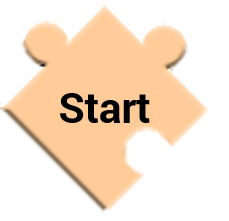Juvenile Reentry Programs: Establishing Clear Program Goals
What Do You Want To Change?
-
Overview
 When it comes to juvenile reentry, “success” may be broadly defined as keeping youth from returning to the justice system (i.e., reducing recidivism). However, juvenile reentry programs often include supplementary measures of success that may help promote positive transitions.
When it comes to juvenile reentry, “success” may be broadly defined as keeping youth from returning to the justice system (i.e., reducing recidivism). However, juvenile reentry programs often include supplementary measures of success that may help promote positive transitions.This section provides steps and strategies that will help you target your primary and secondary goals of your juvenile reentry efforts, whether at the individual- or agency-level.

-
Steps to Take: Lessons Learned from the Research
Steps to Take: Lessons Learned from the Research
Define the local problem and target population.
- Begin by using information about the specific youth population to inform your program.
- Gather specific information on individual needs through interviews and assessment tools.
Set program goals to determine how success will be measured.
- Develop both individual- and agency-level goals.
- Include more specific, secondary goals to supplement the primary goal of reducing recidivism.
- Use a SMART framework to set clear program goals.
Develop an implementation plan and timeline.
- Create an implementation plan that outlines all the necessary steps, personnel, and activities involved in the implementation of a program.
-
Define the Local Problem and Target Population
Start by making sure you understand the problem and population you want to target. Gather a greater understanding of the characteristics of youth who are returning to their communities and the types of services they need. You can do this by analyzing data that may already be available to you.
- Begin by using information about the specific youth population to inform your program. Information on how many or how often youth are returning to juvenile facilities following their release back into the community can help to define the problem your reentry program seeks to solve. Demographic and other more specific information—such as current offense, past offenses, sex, race/ethnicity, and age—is also valuable. For example, Oakland's Second Chance Juvenile Reentry Program analyzed information specifically on the proportion of youth who were convicted of a new nonviolent offense in the first year after reentry, at the pre-implementation stage, to serve as a baseline measure for their process evaluations.
- Gather specific information on individual needs through interviews and assessment tools. Information on the individual needs of potential program participants can also be beneficial when establishing the goals of your reentry program. For example, to assess the treatment needs of youth, the Intensive Aftercare Demonstration Project (Colorado) relied on clinical interviews with juvenile offenders, assessment tools, and an intensive file review process to collect information on common characteristics of their target population. By reviewing available data to determine the most prevalent needs among your population of justice-involved juveniles, you can target those needs in reentry programming.
Take a Look
The Center for Advancing Correctional Excellence at George Mason University has developed a Risk-Needs-Responsivity (RNR) Simulation Tool to assess individuals, agencies, and communities. Specifically, this tool can help you identify the service needs of your target population and assess how well your agency and community is set up to meet those needs.
-
Set program goals to determine how success will be measured.
Program goals tend to be at the individual- and agency-level, and can include primary and secondary goals.
- Develop both individual- and agency-level goals. An example of a program that included both individual- and agency-level goals is the Stabilization and Reintegration Program. Individual-level goals for youth in the program included reduced recidivism rates, personal growth in the form of greater discipline, and more prosocial attitudes. Agency-level goals of the program included reduction of costs by shortening secure confinement stays of youth and alleviating overcrowding in facilities. Another example is the Intensive Aftercare Program, which includes reducing recidivism among high-risk youth, as an individual-level goal, and saving money for the system while providing higher quality supervision services, as an agency-level goal.
- Include more specific, secondary goals to supplement the primary goal of reducing recidivism.While the overall, primary goal of most reentry programs may be to reduce recidivism, more specific, secondary goals to reach this end may also be targeted. For example, while the more general, primary goal of the Operation New Hope program is to reduce recidivism, other secondary goals include decreasing participants' dependence on alcohol or drugs, decreasing rates of their parole violations, and increasing their basic living and employment skills.
- Use SMART goals to set clear program goals. According to this framework, goals should be:
- Specific
- Measurable
- Achievable
- Relevant
- Time-Bound
-
Develop an implementation plan and timeline.
An implementation plan with benchmarks ensures that program goals are met by a given deadline. Separate timelines may be necessary for individual- and agency-level goals, as agency-level goals may take longer to achieve and to measure. Additionally, there should be some flexibility within the plan to account for unanticipated setbacks (for more information, see the Handling Unanticipated Problems or Setbacks).
- Create an implementation plan that outlines all the necessary steps, personnel, and activities involved in the implementation of a program. An implementation plan breaks the program model and objectives into identifiable steps, assigns program components to the proper staff, and indicates how long each step should last. For instance, the Tribal Green Reentry Program dedicated 1 year to developing a strategic plan, logic model, vision and mission, a steering committee, and an advisory board. The implementation plan also detailed three subplans: an action plan, a communication plan, and an evaluation plan.








